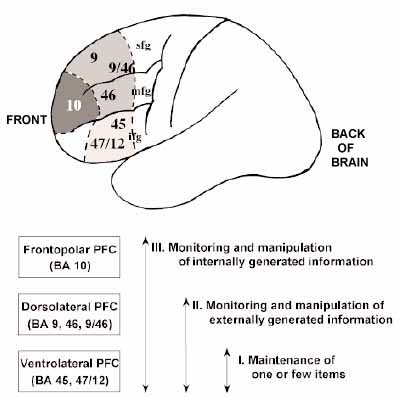Salience network as a hub for consciousness
Thread posts
See all posts in this thread below.
- User
- Message
- Actions
-
-
Published: 07-18-2016 02:46 am
 ChristianISFJ
ChristianISFJ
Updated: 07-18-2016 02:52 am -
Reading about "Salience Network" by V. Menon 2015.
"The two main cortical nodes of the SN serve distinct functions by virtue of their differential inputs and outputs. The AI receives convergent input from multiple sensory modalities including auditory and visual systems.. and there is converging evidence from human neuroimaging studies for its involvement in simultaneous attention to multisensory stimuli .. Other major sources of input include the amygdala, ventral striatum, and the ventral tegmental nuclei, constituting the key subcortical nodes of the SN, which provide access to the emotional and reward saliency of stimuli. Crucially, in addition to its response to external stimuli, the insula is also sensitive to internal signals associated with autonomic processes such as heartbeat, skin conductance, and respiration. These autonomic processes have been linked to interceptive awareness of salient events and likely involve interactions of the SN with the posterior insula."
"The SN not only plays an important role in saliency detection and reactivity but also facilitates access to attention and working memory resources once a salient event has been detected. Emerging evidence suggests that the SN plays a crucial role in switching between large-scale brain networks involved in exter- nally oriented attention and internally oriented mental processes (Sridharan et al., 2008). During the performance of many cognitively demanding tasks, the SN, together with the lateral frontoparietal central executive network, typically shows increase in activation, whereas the default-mode network shows consistent decrease in activation below the resting base- line (Greicius, Krasnow, Reiss, & Menon, 2003; Greicius & Menon, 2004; Raichle et al., 2001). Importantly, brain responses within these regions increase and decrease proportionately and often antagonistically, in relation to specific cognitive demands and subjective task difficulty. Once a salient event is detected, the AI facilitates sustained processing by initiating appropriate tran- sient control signals that engage cognitive and task control sys- tems while suppressing the default-mode network (Sridharan et al., 2008). The right AI node of the SN, in particular, has been shown to be a causal hub for signaling the dorsal fronto- parietal ‘central executive’ network (Figure 10), a system impor- tant for maintaining and manipulating information in working memory (D’Esposito, 2007; Fuster, 2000; Goldmanrakic, 1995; Miller & Cohen, 2001; Smith & Jonides, 1998). The most dramatic evidence for the role of the SN in medi- ating the dynamic interaction between networks comes from studies of patients with traumatic brain injury. Bonnelle and colleagues found that abnormal default-mode network func- tion was specifically predicted by the amount of white matter damage in the SN tract connecting the right AI to the dACC and presupplementary motor area (Bonnelle et al., 2012). These results provide evidences that structural integrity of the SN is necessary for the efficient regulation of activity in the default- mode network and that a failure of this regulation leads to inefficient cognitive control and weaker performance on cog- nitive control tasks. Critically, these switching mechanisms help focus attention on task-relevant stimuli and goals, and as a result, they take on added significance or saliency (Menon & Uddin, 2010; Figure 11). "
It seems that the salience network is always active, regulating large scale networks like the task-positive network and default-mode network in relation to external and internal stimuli, with strong connections to ventral striatum and dopamine-signals. So it seems possible that the core of conscioussness is related to the salience network.
The different components of consciousness:
- Top-down modulation of attention (anti-saccades, selective attention, high working memory, stable dopamine in PFC and ventral striatum)
- Bottom-up modulation of attention (pro-saccades, salient-driven attention, low working memory, higher dopamine in ventral striatum than in PFC)
- Mechanistic / empirical construal (task-positive network)
- Social / symbolic construal (default-mode network)
- Counterfactual / alternative (state-dependent high connectivity to frontopolar cortex)
- Factual / authentic (state-depedent low connectivity to frontopolar cortex)
- Network regulation (salience network)
-
-
-
-
Published: 07-19-2016 03:20 am
 ErikThor
ErikThor -
That's pretty cool. So a problem I have always had with Jung is his two uses for conscious/unconscious. One is intuition (unconscious) and one is sensing (conscious) and he pushes this definition very strongly. So Saliency (Sensing) and less saliency (intuition) - but then he also talks about a function being more or less conscious, for example conscious feeling, or conscious thinking, or conscious sensing. So then he talks about consciousness as your mental state or which state is more used at the moment.
-
-
-
-
Published: 07-20-2016 12:44 pm
 ChristianISFJ
ChristianISFJ
Updated: 07-20-2016 12:46 pm - Yes, it's a though question. I am not so sure of what Jung meant. I believe all people have some form of intuition or nonverbal / vibe-based cognition so I don't believe Jungian Intuitives have a special ability of that. I think that the most meaningful definition of Intuition is higher connectivity with frontopolar and the neocortex and that distant associations are perhaps experienced as unconscious cognition, that's my guess at the moment. Do you believe sensors have a distinct respons to stimuli-indendent thinking / spontaneous thinking / introspection too or is it just the perception of sensations / external stimuli that differs?
-
-
-
-
Published: 07-21-2016 05:09 am
 ErikThor
ErikThor -
Yeah the frontopolar and neocortex does seem more relevant to intuition for sure. And I agree. But I must ask you what we should do with the top-down bottom up dichotomy as it stands at the moment? Is it related to striatal dopamine d2 receptors do you think? Do you think the warning signals of the brain trigger us to enter a top-down response? I.e: Something is wrong here, I need to figure out what, vs "Nothing major is wrong here, I can keep listening to the other person." because maybe a warning signal makes us doubt environmental stimuli? Just a hypothesis.
Like, as it stands at the moment, we don't have a good explanation for why people prefer one network over another: but if network use was regulated by neurotransmitters and receptors in the brain, that would explain what would trigger us to enter for example the task-positive or default-mode network. So maybe the d2 receptors can still be connected to whether we choose a top-down or bottom up strategy. -
-
-
-
Published: 07-21-2016 06:17 am
 ChristianISFJ
ChristianISFJ -
Yes but the key is d2 receptor location. The striatal d2 receptors are included in error-related negativity but d1 and d2 receptors located in frontopolar should, hypothetically influence the connectivity to frontopolar.
Another hypothesis I have is that Sensors might have decrease vibe-awareness because frontopolar cortex lies basically at the same location as vmPFC (ventromedial prefrontal cortex) and this region is associated with vibe-awareness, impulsivity and other things and seems to be related to MAO which we have not associated with any trait before.
"Stronger coupling predicted increased harm avoidance and decreased reward dependence scores, suggesting that this circuitry mediates a part of the association of MAOA with these traits. We utilized path analysis to parse the effective connectivity within this system, and provide evidence that vmPFC regulates amygdala indirectly by influencing rostral cingulate cortex function. Our data implicate a neural circuit for variation in human personality under genetic control, provide an anatomically consistent mechanism for vmPFC–amygdala interactions underlying this variation, and suggest a role for vmPFC as a superordinate regulatory area for emotional arousal and social behavior."
http://www.nature.com/mp/journal/v13/n3/full/4002020a.html


-
-
-
-
Published: 07-21-2016 06:25 am
 ChristianISFJ
ChristianISFJ
Updated: 07-21-2016 08:25 am -
Ok a correction, frontopolar and vmPFC are not the same region but lies very close to each other but they seem to have different functions. Frontal head trauma can sometimes damage both the frontopolar and vmPFC.
"Using a Bayesian reinforcement-learning model and fMRI, we show that frontopolar cortex (FPC) tracks the relative advantage in favor of switching to a foregone alternative when choices are made voluntarily. Changes in FPC functional connectivity occur when subjects finally decide to switch to the alternative behavior. Moreover, interindividual variation in the FPC signal predicts interindividual differences in effectively adapting behavior. By contrast, ventromedial prefrontal cortex (vmPFC) encodes the relative value of the current decision. Collectively, these findings reveal complementary prefrontal computations essential for promoting short- and long-term behavioral flexibility."
http://www.sciencedirect.com/science/article/pii/S0896627309003894 -
-
-
-
Published: 07-21-2016 08:33 am
 ChristianISFJ
ChristianISFJ -
It seems like Intuitives should have more accurate introspection in our model
"We show that introspective ability is correlated with gray matter volume in the anterior prefrontal cortex, a region that shows marked evolutionary development in humans. Moreover, interindividual variation in introspective ability is also correlated with white-matter microstructure connected with this area of the prefrontal cortex. Our findings point to a focal neuroanatomical substrate for introspective ability, a substrate distinct from that supporting primary perception."
http://science.sciencemag.org/content/329/5998/1541
They link anterior prefrontal cortex (aPFC) with introspective accuracy and aPFC is the same thing as frontopolar cortex or Broadmann area 10 (BA10). It's not easy to keep up with the synonyms.
"FPC and vmPFC perform complementary computations during voluntary decision making. Whereas FPC encodes the long-term evidence collected in favor of adapting future behavior, vmPFC encodes a short-term signal reflecting a comparison between the currently chosen and alternative actions. The existence of such signals suggests a novel mechanism for deciding whether or not it is worth adapting or maintaining decisions."
http://www.sciencedirect.com/science/article/pii/S0896627309003894
Basically it seems like:
- Intuitives in our model have strong frontpolar connectivity relative to vmPFC connectivity
- Sensors in our model have strong vmPFC connectivity relative to frontopolar connectivity
- Intuitives in our model have a more abstract cognition that also is used for stimuli-indepedent thinking and not just external stimuli
-
-
- User
- Message
- Actions